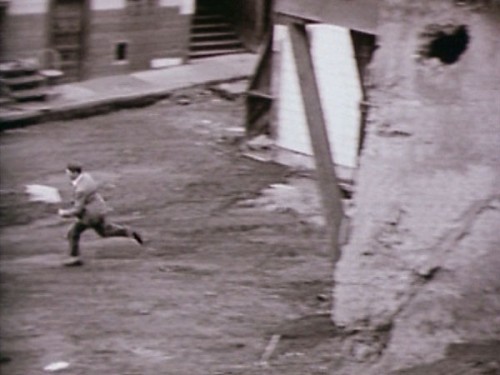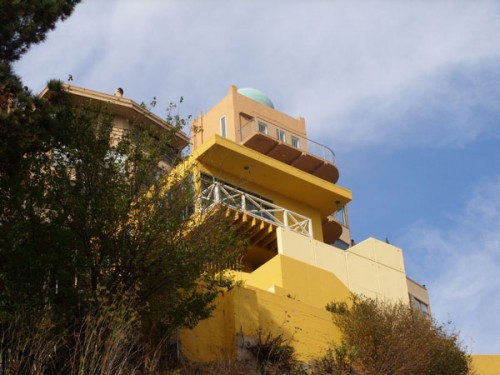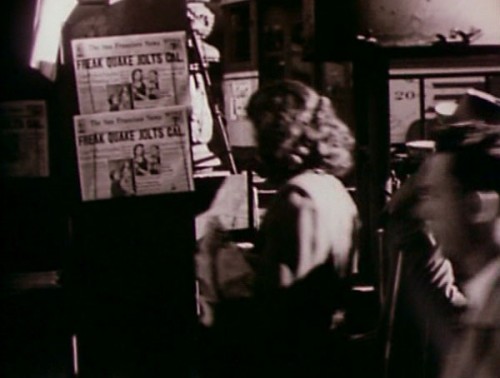In Search of Christopher Maclaine 4: The THE END Tour - A Work in Progress 3: WALTER B
This is the forth in a multipart series unofficially conjoined to the publication of Radical Light: Alternative Film & Video in the San Francisco Bay Area, 1945–2000, and the accompanying film series currently being presented by the Pacific Film Archive and San Francisco Cinematheque (in partnership with SFMOMA).
With my friend Brian Darr, proprietor of the great Bay Area cinephilia blog Hell on Frisco Bay, I’ve been scouting out the San Francisco locations used in Christopher Maclaine’s Masterpiece, THE END. What began as an attempt to identify and document what physically remains of the often mysterious places at which THE END was shot has evolved into a larger project to also analyze the film, and to identify all its many actors and extras, all of whom appear uncredited. To read the full version of these preliminary remarks, including info on how YOU can participate in this project, click here. For further information on Maclaine, check out the intro, which serves as this series’ hub. For the previous post of this Tour, click here.
NEW FEATURE: a Youtube of the WALTER episode is viewable here.
NOTE: portions of Maclaine’s Voice-Over narration are transcribed in italicized sections. The images, for the most part, are stills documenting many (but by no means all) of THE END‘s shots. Those unfamiliar with this film will probably want to watch the video clip found above first, before making their way through the (hopefully enjoyable) notes and explication.
We now return to the world of the film’s first character, WALTER:
But our little friend …
20) Walter dashes down an unidentified alley (probably on Telegraph Hill) as Maclaine’s signature bagpipes, previously heard during the film’s introduction, return on soundtrack. This particular piece will be heard throughout the rest of the brief Walter narrative, indicating Maclaine’s profound identification with this character in his climatic phase.
21) Unidentified location. At the beginning of shot, Walter appears to have entered from screen left. He takes off his dark sunglasses, drops them to the ground in front of him, looks down to stare at them.
22) The sunglasses lie in sand. Two interesting things about this shot: a) there is no evidence in the previous or following shots that the ground in front of Walter consists of sand — images of sand, the ocean, the beach, etc., will feature throughout THE END, associated in the film with deliverance, both by death and other means, and, b) as far as I’m able to tell, this is the only classical Point of View (POV) edit in the film — that is, the only cut from a shot of someone looking, to another of what he sees. This is a significant touch: Walter is contemplating the dropping of his mask (or persona); he is in the final stages of unraveling. For a moment, we are drawn into his perspective, even if only unconsciously.
23) Continuation of shot in picture #21. Walter darts screen left, ducks down stairs. (Location unidentified.)
Our little friend could not face the 20th century, so he went running …
24) A Kodachrome shot of Seal Rocks (?).
… only there was no place to run to, all the exits were covered.
25) Walter reaches bottom of stairs last seen in #23 (location unidentified).
Everywhere he ran, there were people leering at him, and saying
26) Walter makes a mad dash through an urban ruin. Maclaine cuts to a flurry of seemingly random associative/metaphorical mindscreen imagery (sometimes cutting back to further moments of Walter’s traversal of this space ), some of which is reproduced in still form in pictures 27–28, 30, and 32–38, as follow:
Go,
27) Unidentified location. This is the second in a series of Kodachrome shots taken through window(s) of shoe store(s). The first had been of a pair of relatively plain men’s shoes. In this fast-paced montage, there is a balance of feminine- and masculine-charged imagery, but the feminine images are particularly striking. This, of course, could be reflective of the human female propensity to accrete artificial plumage. My reading of this, however, is that Maclaine is drawn to highly sexualized feminine imagery in the creation of Walter’s apocalyptic world, even if there is no direct allusion to eroticism. Having just removed his persona (in the form of his sunglasses), Walter experiences a flood of anima imagery, congruent with one, like Stan Brakhage would describe the later Maclaine, about to “pitch off the earth.”
Go,
28) This image appeared to Brian to have been shot somewhere on Telegraph Hill. The dilapidated house, surrounded by a wrecked wooden structure of some kind, in the foreground, is consonant with Walter’s discombobulated and decomposing outer shell. The tall white building, which appears to be at the top of the hill in the background, is capped by a dome, suggestive of an observatory, planetarium, or mosque, all of which are connected literally or symbolically to the cosmos. The whole image is a lucid metaphor for the psyche of one, again, about to “pitch off the earth.”
29) A recent photo taken in a parking lot on Broadway, near its intersection with Kearny, from a position/angle approximately the same as that of picture #28, above. For years when I walked by this domed building, I was reminded of the one in THE END, only it seemed built on a smaller scale. This proved to be a misjudgment: a tip from Wilder Bentley led Brian and myself to identify the two beyond a doubt as one and the same. They, or, rather, it, is Pasquale’s Tower, built in 1930 by baker/hotelier Pasquale Gogna. One of the legendary structures of Telegraph Hill, this tower located at the end of Dunne’s Alley consists of four small square rooms stacked together and topped with a dome in a supposedly “Genoese manner.”
Go …
30) Another anima image, in this case supplemented by flowers (see #10).
31) In the same unidentified location as #26, Walter continues his dash. Camera pans to follow, revealing further details of the urban ruin.
Soon he would be able to run no more …
32) A large poster (perhaps 6-sheet size?) in an unidentified outdoor location, which I believe to be for the 1948 re-release of the 1940 film The Invisible Woman, starring John Barrymore. Why a poster deployed in ’48 would be found mounted somewhere outside around ’53, and then appear in a film shot at that time, is anybody’s guess. The driven yet fragile Walter is ironically compared to a mad scientist (Barrymore) pushing decrepitude. The hunt for an invisible woman is an apt metaphor for the anima quest.
… soon he would fall down and dream.
33) In an unidentified shop window, a male mannequin sits with the November 1952 issue of Esquire in his lap. Although the film rolls on the magazine’s cover are for still photography, to me (and I believe to most viewers) this image reads: movies. Is Walter’s desire to “fall down and dream” ironically compared to the movie-dream life of a brainless dummy? The montage of images 26–38 more than once has been seen as evidence of Walter suffering from the psychic impact of mass society/mass media. While this is a different reading from the one I’m proposing here, I don’t see the two as contradictory or mutually exclusive — and, in fact, I subscribe to them both. This image is one of the best buttresses to arguments along the society/media impact lines.
34) Unidentified woman in front of an unidentified pet store (BTW — weren’t we just speaking of plumage? See text under #27 and parakeets painted on store window above).
Further than that …
35) A fantastically beautiful Kodachrome shot of Tulips being manhandled by a male vendor. See discussions of flowers as anima (soul) representations under pictures 10 and 30, above.
… he had no plans.
36) The San Francisco News headline reads “FREAK QUAKE JOLTS CAL.” Similarly, Walter’s psyche is in the process of being quaked and jolted, rendering him a “freak.” Brian and Wilder Bentley have both done research to ascertain the date and epicenter of this quake. Thus far the results have been inconclusive, but Brian’s money is on a 6.0 trembler occurring on November 22, 1952, inland from San Simeon.
But he could not fall down …
37) These last four shots (34–37) constitute a minor orgasm of anima imagery, culminating in this shot of a beautiful and sad-seeming female mannequin. Does she impel an unconscious awareness in Walter of his anima, or is she the empty soul of a brain-dead, psyche-invading society? Perhaps both? (And hence his dilemma?)
… as long as there were people around.
38) An unidentified actor in an unidentified (but not unidentifiable) location (Brian and I haven’t yet given this one our full attention). This actor looks at the camera with complicity, suggesting he and Maclaine (and/or cinematographer Jordan Belson) might have been friends. It is ironic that this affable seeming fellow represents “people” whose threatening gaze keeps Walter from his desire to “fall down and dream.”
Soon he would fall …
39) Walter shambles up the steps of a hill.
When he awoke he would run no more.
40) Walter begins to shuck off his jacket. As with his sunglasses, he’s in the process of discarding his outer shell.
41) These unidentified men are two further examples of “people around,” preventing Walter from fulfilling his need to “fall down and dream.” At or near the corner of Broadway and Columbus streets in San Francisco’s North Beach district, Pucci’s House of Pisco was a bar with an identity as a purveyor of Pisco Punch, a classic San Francisco cocktail now largely forgotten. Without yet having proof positive, Brian and I have strong indications this location in 1964 became the infamous Condor.
He would … either … Or …
42) Jacketless, Walter continues his shamble.
43) The arm flexed to the extreme point of tension (see #11).
Just over this hill. Surely then he would fall and sleep …
44) In one of THE END’s longest shots, the image of this seagull flying against the wind above Seal Rocks (?) serves as a moving metaphor for Walter’s fraught journey, underlined by the seemingly increased prominence of Walter/Maclaine’s bagpipe theme for the shot’s duration. At one point, the bird is forced to take an unplanned dive, a situation seemingly related to Walter’s desire to “fall and sleep.”
Just over this hill …
45) We see Walter from a reverse angle, shooting down from a position close to the hill’s summit.
46) A harsh, bitter editorial expression of Walter’s situation. This is Brechtian cinematic dramaturgy to the max.
But, No.
47) We see Walter in Closeup for the first time. His expression swiftly passes from shocked openness to poignancy. Is he about to find peace in dreams? Maclaine’s Voice-Over narration immediately negates this possibility. Interestingly, there is a slight trace of exaltation in Maclaine’s vocal delivery of this brief line, “But, No,” indicating both a suicidal ideation of Walter’s impending end, and a wry authorial distance redolent of modernist and proto-postmodern stances and tactics.
For reasons we know nothing about, just at that moment, another man decided to blow the head off the next person he saw … Our friend was that person.
48) The camera pans to follow this gun and the hand holding it as they move to dispatch Walter. The finger squeezes the trigger. A bullet is discharged. A puff of smoke fills the air.
49) We cut to black. Bagpipe music fades out. Maclaine’s Voice-Over narration continues on soundtrack, concluding Walter’s tale, then sliding into a brief but potent précis on his unnamed assassin:
He had only a few minutes to go. If he had only known, he could have lain down and dreamed … Then, he would have passed from one dream into … the Next … If there were only more time, we could have the story on the unhappy young man who decided to blow Walter’s brains out on his last day. We could follow him through his tribulations in the courthouse, could follow him into solitary confinement, could sit with him while his head was being shaven, as he lay whimpering and alone, confused and defeated … We could walk beside him down the gray and sanitary prison corridor, toward the mercy we offer to those of us who run Amok. We could watch through the window as he strangles to death, trying to catch a breath to say “mama.” No, we have not enough time for all of the stories, let us go on … Maybe you will see yourself …
BREAKING NEWS: My collaborator Brian Darr followed up on the lead provided by Christian Bruno in the comments section of last week’s post and procured Yvonne Rainer’s autobiography, Feelings Are Facts: A Life from the library. Rainer indeed delivers important revelations: her lover, as a seventeen-year-old college student, was a member of the Beat scene and a North Beach habitué in his early thirties named Jack Warn. Warn made a living hustling sailors on shore leave into a lower–Market Street photo studio for swift pics, and dressed pretty much like our friend Walter, only with sandals. Rainer watched as scenes from Warn’s section of THE END were shot on an Alta Plaza Park stairway, which could be seen from her dorm room at Clay and Pierce. Although Rainer doesn’t give the name of Warn’s character in Maclaine’s film, from this very strong circumstantial evidence, it seems crystal clear that Warn indeed played Walter (see Closeup in picture #47, above). Brian got this news to me only a few hours before I was scheduled to post — excellent timing, Brian! This info will soon be integrated into its proper places within the WALTER posts, but, given its semi-down-to-the-wire nature, it seemed best to present it in the current manner for the time being. Thanks again, Christian!
Click here for the next post in this series, the first episode devoted to CHARLES.
Click as indicated for the previous post of this Tour. Click as indicated for the intro to this series.
If you have any information or (nonpublic) feedback to contribute to the Tour, please click here.





























